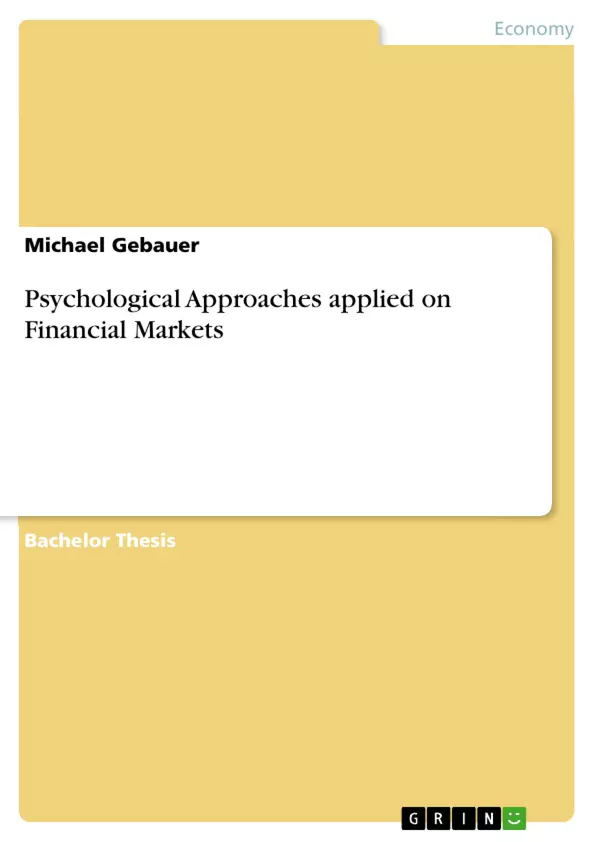This Paper works out how psychological approaches can be applied on financial bubbles. The thesis shows that it is impossible to explain financial bubbles clearly and without flaws with classical rationality and perfect markets. Furthermore this paper tries to unite various behavioral approaches to explain financial bubbles in a more realistic way. Financial bubbles imagine a great importance for the entire economy, caused by their strong economic impact. Therefore an understanding of these bubbles is crucial to counteract them. To gain the aspired results the paper will present empirical studies and inconsistencies in classic economic theory. Additionally it will adjust alternative behavioral models for financial bubbles. It will be shown how human behavior leads to inherent mistakes at financial markets, which cause financial bubbles.
Diese Arbeit beschäftigt sich mit der Anwendung von psychologischen Verhaltensmodellen auf Finanzmärkte zur Erklärung von Finanzblasen. Es wird verdeutlicht werden, dass aus der klassischen Ökonomie stammende Theorien nicht in der Lage sind Finanzblasen fehlerfrei und eindeutig zu erklären. Daher bedient diese Arbeit sich psychologischer Modelle um Finanzblasen realitätsnäher zu erklären. Durch ihre immense Wirkungskraft beeinflussen Finanzblasen die gesamte Wirtschaft.
Deswegen ist es außerordentlich wichtig diese zu verstehen um rechtzeitig Kontrollmaßnahmen einzuleiten. Um die angestrebten Resultate zu erreichen bedient sich diese Arbeit mehrerer empirischer Studien sowie Unregelmäßigkeiten in der klassisch ökonomischen Theorie. Weiterhin werden psychologische Modelle in einem einheitlichen Erklärungsmodell angepasst werden um Finanzblasen zu erklären. Dieses Modell wird verdeutlichen, dass es in der menschlichen Natur liegt Fehler zu machen. Diese Fehler führen auf den Finanzmärkten zu Finanzblasen.
Inhaltsverzeichnis (Table of Contents)
- INTRODUCTION
- Task of the Paper
- Methodology
- FOUNDATIONS OF BUBBLE RESEARCH
- Understanding Bubbles - A Crucial Point
- Locusts and Financial Bubbles
- Feedback cycles of financial markets.
- Bubbles in a historical Perspective
- Understanding Bubbles - A Crucial Point
- RATIONAL BUBBLES WITH CONVENTIONAL RATIONALITY AND
PERFECT MARKETS
- Perfect Financial Markets
- Present Value Model
- Efficient Market Hypothesis
- Classical Rational Behavior under Risk and Uncertainty
- Axioms of the EUM.
- Expected Utility and von Neumann – Morgenstern Utility Function.
- Rational Bubbles
- Rational Expectations and Identical Information
- Asymmetric Information.
- Anomalies and Deviations of the EUM
- The Allais Paradox
- The Disposition Effect
- Conclusions for the Classical Model in Bubble Research.
- Imperfect Markets
- Consequences for Rationality
- Perfect Financial Markets
- THE DEVIATION FACTOR HYPOTHESIS
- Bounded Rationality adjusted for Financial Bubbles.
- Non-optimal Decision Making
- Detection of Decision Mistakes
- Inherent Decision Mistakes
- Exceeded Non - Rational Behavior
- Over Confidence and Euphoria.
- Fear
- Indicators for Non - Rational Behavior and Difficulties in Observation
- Leading Indicators of Confidence
- Indices in Appliance and Limits of Measurement
- Bounded Rationality adjusted for Financial Bubbles.
- CRITICAL ACCLAIM
- Bubble- and Crisis Research.
- Psychological Approaches
- Critique on the Deviation Factor Hypothesis
Zielsetzung und Themenschwerpunkte (Objectives and Key Themes)
This paper explores the application of psychological models to financial markets, specifically in understanding and explaining financial bubbles. It examines the limitations of traditional economic theories in accurately describing these phenomena and seeks to provide a more realistic explanation through behavioral models. The paper emphasizes the importance of understanding financial bubbles due to their significant impact on the global economy and argues that understanding these bubbles is crucial for implementing effective countermeasures.- The limitations of classical economic theories in explaining financial bubbles.
- The application of psychological models to provide a more realistic understanding of financial bubbles.
- The importance of understanding financial bubbles for effective countermeasures.
- The role of human behavior in creating financial bubbles.
- The analysis of empirical studies and inconsistencies in classical economic theory.
Zusammenfassung der Kapitel (Chapter Summaries)
The first chapter introduces the paper's objective, which is to understand how psychological approaches can be applied to financial markets to explain financial bubbles. The second chapter lays the foundation for understanding bubbles by examining their historical context and discussing the concept of feedback cycles in financial markets. The third chapter explores the classical economic theory of rational bubbles, highlighting the limitations of the efficient market hypothesis and the expected utility model. The fourth chapter introduces the concept of the deviation factor hypothesis, which adjusts bounded rationality to account for financial bubbles, and delves into the inherent decision mistakes that can lead to these phenomena. The fifth chapter presents a critical analysis of existing research on bubbles and crises, specifically focusing on psychological approaches and their limitations.Schlüsselwörter (Keywords)
Financial bubbles, behavioral finance, bounded rationality, psychological models, deviation factor hypothesis, empirical studies, classical economic theory, efficient market hypothesis, expected utility model, risk and uncertainty, decision mistakes, overconfidence, fear, feedback cycles, crisis research.- Quote paper
- Michael Gebauer (Author), 2013, Psychological Approaches applied on Financial Markets, Munich, GRIN Verlag, https://www.grin.com/document/274594



